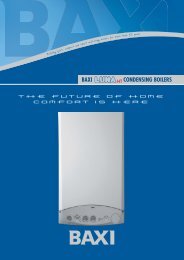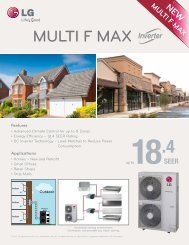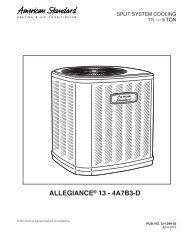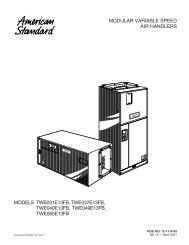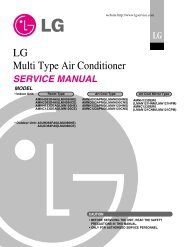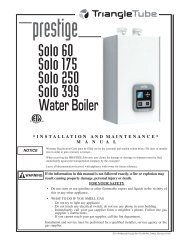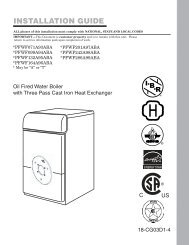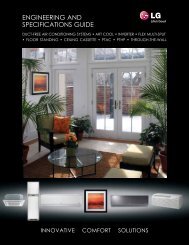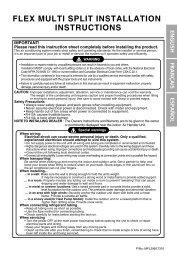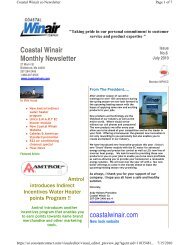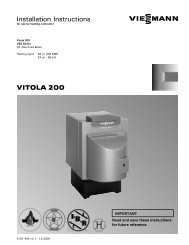INSTALLATION OPERATION MAINTENANCE - Coastal Winair
INSTALLATION OPERATION MAINTENANCE - Coastal Winair
INSTALLATION OPERATION MAINTENANCE - Coastal Winair
Create successful ePaper yourself
Turn your PDF publications into a flip-book with our unique Google optimized e-Paper software.
Start-UpReturn Air Smoke DetectorThe return air smoke detector is designed to shut off the unitif smoke is sensed in the return air stream. Sampling the airflowentering the unit at the return air opening performs thisfunction.In order for the smoke detector to properly sense smoke inthe return air stream, the air velocity entering the unit mustbe between 500 and 4000 feet per minute. Equipment coveredin this manual will develop an airflow velocity that fallswithin these limits over the entire airflow range specified inthe evaporator fan performance tables.There are certain models however, if operated at low airflow,will not develop an airflow velocity that falls within therequired 500 to 4000 feet per minute range. For these models,the design airflow shall be greater than or equal to theminimum CFM specified in the table provided below. Failureto follow these instructions will prevent the smoke detectorfrom performing its design function.Economizer Start-UpReliaTel ControlUsing the Service Test Guide in Table 6, momentarily jumpacross the Test 1 & Test 2 terminals on LTB1 one time tostart the Minimum Ventilation Test.Electro Mechanical ControlUsing the Service Test Guide perform the proper test modeconnections.1. Set the minimum position setpoint for the economizer tothe required percentage of minimum ventilation using thesetpoint potentiometer located on the Economizer Control(ECA).The economizer will drive to its minimum positionsetpoint, exhaust fans (if applicable) may start at random,and the supply fan will start when the SERVICE TEST isinitiated.WARNINGRotating Components!During installation, testing, servicing and troubleshootingof this product it may be necessary to measure thespeed of rotating components. Have a qualified or licensedservice individual who has been properly trainedin handling exposed rotating components, perform thesetasks. Failure to follow all safety precautions when exposedto rotating components could result in death or seriousinjury.The Exhaust Fan will start anytime the economizer damperposition is equal to or greater than the exhaust fan setpoint.2. Verify that the dampers stroked to the minimum position.ReliaTel ControlMomentarily jump across the Test 1 & Test 2 terminals onLTB1 one additional time if continuing from previous componentstart-up or until the desired start-up component Testis started.Electro Mechanical ControlUsing the Service Test Guide perform the proper test modeconnections.3. Verify that the dampers stroked to the full open position.4. To stop the SERVICE TEST, turn the main power disconnectswitch to the “Off” position or proceed to the nextcomponent start-up procedure. Remove electro mechanicaltest mode connections (if applicable).Compressor Start-Up1. Attach a set of service gauges onto the suction and dischargegauge ports for each circuit. Refer to the refrigerantcircuit illustration in the Service Facts.ReliaTel ControlMomentarily jump across the Test 1 & Test 2 terminals onLTB1 one additional time if continuing from previous componentstart-up or until the desired start-up component Testis started.Electro Mechanical ControlUsing the Service Test Guide perform the proper test modeconnections.Scroll Compressorsa. Once each compressor has started, verify that the rotationis correct. If a scroll compressor is rotating backwards, itwill not pump and a loud rattling sound can be observed.b. If the electrical phasing is correct, before condemning acompressor, interchange any two leads (at the compressorTerminal block) to check the internal phasing. Refer tothe illustration in Figure 5-1 for the compressor terminal/phase identification. If the compressor runs backward foran extended period (15 to 30 minutes), the motor windingcan overheat and cause the motor winding thermostatto open.2. After the compressor and condenser fan have started andoperated for approximately 30 minutes, observe the operatingpressures. Compare the operating pressures tothe operating pressure curve in the Service Facts.3. Check system superheat. Follow the instruction listed onthe superheat charging curve in the Service Facts.Superheat should be within ±5 F of the superheat chartvalue.4. Repeat steps 1 through 4 for each refrigerant circuit.5. To stop the SERVICE TEST, turn the main power disconnectswitch to the “Off” position or proceed to the nextcomponent start-up procedure. Remove electro mechanicaltest mode connections (if applicable).Dehumidification OptionMomentarily jump across the Test 1 and Test 2 terminals ofthe LTB1 until the unit enters test mode 7. (See Table 6.)Once the unit is in the reheat test mode, verify that the 3 wayvalve has shifted to the reheat position and that the supplytemperature rises 10 deg F more than when in coolingmode stage 2. Monitor the suction pressure for 15 minutes.The suction pressure should remain within 5 psi of normal35



